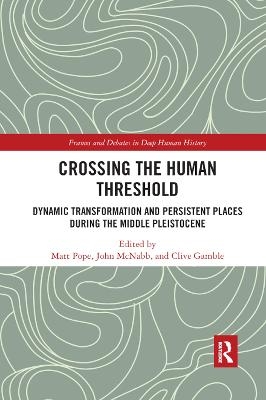
Crossing the Human Threshold
Routledge (Verlag)
978-0-367-87847-4 (ISBN)
When was the human threshold crossed? What is the evidence for evolving humans and their emerging humanity? This volume explores in a global overview the archaeology of the Middle Pleistocene, 800,000 to 130,000 years ago when evidence for innovative cultural behaviour appeared. The evidence shows that the threshold was crossed slowly, by a variety of human ancestors, and was not confined to one part of the Old World.
Crossing the Human Threshold examines the changing evidence during this period for the use of place, landscape and technology. It focuses on the emergence of persistent places, and associated developments in tool use, hunting strategies and the control of fire, represented across the Old World by deeply stratified cave sites. These include the most important sites for the archaeology of human origins in the Levant, South Africa, Asia and Europe, presented here as evidence for innovation in landscape-thinking during the Middle Pleistocene. The volume also examines persistence at open locales through a cutting-edge review of the archaeology of Northern France and England.
Crossing the Human Threshold is for the worldwide community of students and researchers studying early hominins and human evolution. It presents new archaeological data. It frames the evidence within current debates to understand the differences and similarities between ourselves and our ancient ancestors.
Clive Gamble is Emeritus Professor in the Centre for the Archaeology of Human Origins (CAHO) at the University of Southampton and a Visiting Fellow in the Department of Geography, Royal Holloway. From 2004-11 he was co-director of the British Academy Centenary research project ‘Lucy to Language – the Archaeology of the Social Brain’. His recent books include Settling the earth: the archaeology of deep human history (2013) and Thinking Big: how the evolution of social life shaped the human mind (2014), with John Gowlett and Robin Dunbar John McNabb is a member of the Centre for the Archaeology of Human Origins at the University of Southampton. He is interested in the social aspects of technology and material culture with especial reference to the Acheulean and the Lower Palaeolithic/Earlier Stone Age. He has worked extensively in Europe and Africa. Matt Pope is a research fellow at the Institute of Archaeology, University College London and Deputy Director of the Boxgrove Project. He is interested in patterning the use, transportation and discard of artefacts by early humans, taphonomic processes and the geological context of Middle Pleistocene human occupation. He is currently exploring the role of bifacial technology and tool curation behaviour in Lower Palaeolithic hunting strategies and social organization.
i. Dedication and acknowledgements; ii. Contributors; iii. List of Figures and Tables; iv. Glossary; Section 1: Frames for interpretation: persistence and thresholds in the Middle Pleistocene; CHAPTER 1. Thresholds in hominin complexity during the Middle Pleistocene: a persistent places approach; CHAPTER 2. Thresholds in behaviour, thresholds of visibility: landscape processes, asymmetries in landscape records and niche construction in the formation of the Palaeolithic record; Section 2: Regional Case studies: dynamic transformation in Western Europe and the Levant; CHAPTER 3. The road to differentiated land use and domestic space in the Middle Pleistocene of Southwestern Asia; CHAPTER 4. A land of flint and fallow-deer: human persistence at Middle Pleistocene Qesem Cave; CHAPTER 5. On the co-evolution of hearth and home-making during the Middle Pleistocene in the Levant; CHAPTER 6. Land use in Brittany during the Middle Pleistocene: the example of the persistent place of Menez-Dregan I (Plouhinec, Finistère); CHAPTER 7. La Cotte de St Brelade: place making, assemblage and persistence in the Normano-Breton Gulf; CHAPTER 8. Landscapes of habit and persistent places during MIS 11 in Europe. A return journey from Britain; CHAPTER 9. Thresholds in lithic technology and human behaviour during MIS9 in Britain; CHAPTER 10. Neither hot nor cold but dry: a Northwest European view of Neanderthal environments in late MIS 7 and beyond; CHAPTER 11. From the Middle to the Upper Pleistocene: origins and diversification of the Middle Palaeolithic in Northwest France; Section 3: Global Debates; CHAPTER 12. Everyday tasks demonstrate cognitive complexity in Africa’s Middle Stone Age; CHAPTER 13. A major event in the Middle Pleistocene?; CHAPTER 14. Persistent places, resident predators and vigilant faunas: life in Eurasia in Eurasia in the late Middle Pleistocene
| Erscheinungsdatum | 16.12.2019 |
|---|---|
| Reihe/Serie | Frames and Debates in Deep Human History |
| Verlagsort | London |
| Sprache | englisch |
| Maße | 156 x 234 mm |
| Gewicht | 453 g |
| Themenwelt | Geisteswissenschaften ► Archäologie |
| Geschichte ► Allgemeine Geschichte ► Vor- und Frühgeschichte | |
| Naturwissenschaften ► Biologie ► Evolution | |
| ISBN-10 | 0-367-87847-X / 036787847X |
| ISBN-13 | 978-0-367-87847-4 / 9780367878474 |
| Zustand | Neuware |
| Haben Sie eine Frage zum Produkt? |
aus dem Bereich


